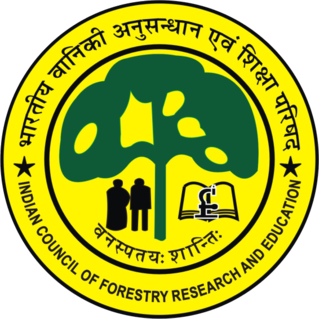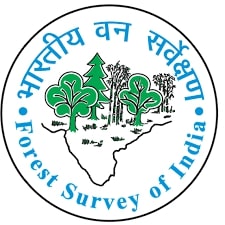Project Tiger is a wildlife conservation movement initiated in India to protect the endangered tiger. The project was initiated in 1973 by the Ministry of Environment, Forest and Climate Change of the Government of India. As of March 2024, there are 55 protected areas that have been designated as tiger reserves under the project. As of 2023, there were 3,682 wild tigers in India, which is almost 75% of the world's wild tiger population.

Dehradun, also known as Dehra Doon, is the capital and the most populous city of the Indian state of Uttarakhand. It is the administrative headquarters of the eponymous district and is governed by the Dehradun Municipal Corporation, with the Uttarakhand Legislative Assembly holding its winter sessions in the city as its winter capital. Part of the Garhwal region, and housing the headquarters of its Divisional Commissioner, Dehradun is one of the "Counter Magnets" of the National Capital Region (NCR) being developed as an alternative centre of growth to help ease the migration and population explosion in the Delhi metropolitan area and to establish a smart city in the Himalayas.

West Champaran is an administrative district in the state of Bihar in India, located just 60 km (37 mi) west of Birgunj. It is the largest district in Bihar with an area of 5,228 km2(2,019sq mi). It is a part of Tirhut Division. The district headquarters are located in Bettiah. The district is known for its open border with Nepal. One of the major location in West Champaran is Kumar Bagh for SAIL Special Processing Unit and Bhitiharwa where Mahatma Gandhi started Satyagrah Aandolan.

Bandhavgarh National Park is a national park of India, located in the Umaria district of Madhya Pradesh. Bandhavgarh, with an area of 105 square kilometres (41 sq mi), was declared a national park in 1968 and then became Tiger Reserve in 1993. The current core area is spread over 716 square kilometres (276 sq mi).

The Indian Forest Service (IFS) is the premier forest service of India. It was constituted in the year 1966 under the All India Services Act, 1951.

The Forest Research Institute is a Natural Resource Service training institute of the Indian Council of Forestry Research and Education and is an institution in the field of forestry research in India for Indian Forest Service cadres and all State Forest Service cadres. It is located at Dehradun in Uttarakhand, and is among the oldest institutions of its kind. In 1991, it was declared a deemed university by the University Grants Commission.

There are four categories of protected areas in India, constituted under the Wildlife Protection Act, 1972. Tiger reserves consist of areas under national parks and wildlife sanctuaries. There are 53 tiger reserves in India. As of January 2023, the protected areas of India cover 173,629.52 square kilometres (67,038.73 sq mi), roughly 5.28% of the total geographical area of the country.

The Bandhavgarh Fort is situated in Bandhavgarh in Umaria district of Madhya Pradesh, India. It is located on the Bandhavgarh hill, rising 811 meters above sea level at the centre of the Bandhavgarh National Park. It is surrounded by many smaller hills separated by gently sloping valleys. These valleys end in small, swampy meadows, locally known as 'bohera'.

The Indian Council of Forestry Research and Education (ICFRE) is an autonomous organisation or governmental agency under the MoEFCC, Government of India. Headquartered in Dehradun, its functions are to conduct forestry research; transfer the technologies developed to the states of India and other user agencies; and to impart forestry education. The council has 9 research institutes and 4 advanced centres to cater to the research needs of different bio-geographical regions. These are located at Dehradun, Shimla, Ranchi, Jorhat, Jabalpur, Jodhpur, Bengaluru, Coimbatore, Prayagraj, Chhindwara, Aizawl, Hyderabad and Agartala.

The Ministry of Environment, Forest and Climate Change (MoEFCC) is an Indian government ministry. The ministry portfolio is currently held by Bhupender Yadav, Union Minister of Environment, Forest and Climate Change.
Environment policies of the Government of India include legislations related to environment.

India is one of the most biodiverse regions and is home to a large variety of wildlife. It is one of the 17 megadiverse countries and includes three of the world's 36 biodiversity hotspots – the Western Ghats, the Eastern Himalayas, and the Indo-Burma hotspot.

Forest Survey of India (FSI), founded in June 1981 and headquartered at Dehradun in Uttarakhand, is the Government of India Ministry of Environment, Forest and Climate Change organization which conducts forest surveys, studies and researches to periodically monitor the changing situations of land and forest resources and present the data for national planning, conservation and sustainable management of environmental protection as well as for the implementation of social forestry projects.

The Katarniaghat Wildlife Sanctuary is a protected area in the Upper Gangetic plain, near Bahraich city in Bahraich district of Uttar Pradesh, India and covers an area of 400.6 km2 (154.7 sq mi) in the Terai of the Bahraich district. In 1987, it was brought under the purview of the Project Tiger, and together with the Kishanpur Wildlife Sanctuary and the Dudhwa National Park it forms the Dudhwa Tiger Reserve. It was established in 1975.

The Dudhwa Tiger Reserve is a protected area in Uttar Pradesh that stretches mainly across the Lakhimpur Kheri and Bahraich districts and comprises the Dudhwa National Park, Kishanpur Wildlife Sanctuary and Katarniaghat Wildlife Sanctuary. It covers an area of 1,284.3 km2 (495.9 sq mi). Three large forested areas are extant within the reserve, although most of the surrounding landscape is agricultural. It shares the north-eastern boundary with Nepal, which is defined to a large extent by the Mohana River. It ranges in altitude from 110 to 185 m, and several streams flow through the reserve from the northwest across the alluvial plain that encompasses the reserve.
Shahgarh Landscape or Shahgarh Bulge Landscape is located in Jaiselmer District in Indian state of Rajasthan. This area is protected area for reintroduction of cheetah. The nearest city to this area is Jaiselmer. This area fences along the Indo - Pak border. This area is about 4000 km2 and has about 80 human settlements each having about 5 - 10 houses. Chinkara will be the primary prey for cheetah as the prey diversity is less in this region. Cheetah have been declared extinct in India in 1952.
Hemendra Singh Panwar is an Indian conservationist and civil servant, known for his efforts in the fields of wildlife and conservation. He was the first director of the Wildlife Institute of India and was the director of Project Tiger. The Government of India honoured him, in 2013, with Padma Bhushan, the third-highest civilian award, for his services to the environment and conservation.
Sanjiv Chaturvedi is an Indian Forest Service (IFS) officer posted as Chief Conservator of Forest (Research) at Haldwani in the Nainital district of Uttarakhand. Chaturvedi was a Chief Vigilance Officer (CVO) at AIIMS, New Delhi from 2012 to 2014, and served in the government of Haryana from 2005 to 2012.
The 2020 Uttarakhand forest fires started in late May, after several forest fires broke out in Srinagar of Pauri Garhwal district in Uttarakhand, India. As of 24 May 2020, 46 fires were reported covering around 71 hectares and 2 people have died.













